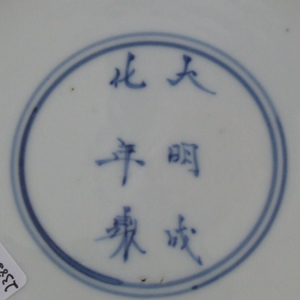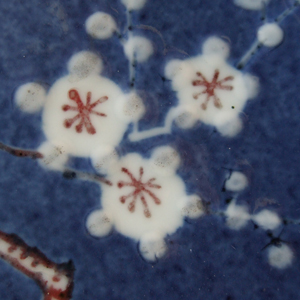
KANGXI 1662 – 1722 Chinese Export Porcelain
A Kangxi Powder Blue Dish c.1700. The Saucer Shaped Kangxi Porcelain Dish Shows a Gnarled Old Prunus Tree with It`s Roots Exposed Flowing on a Spring Evening. The Complex Decorative Scheme Uses a Powder-Blue Ground with Wax Resist Used to Create the Tree and the Moon as Well as the Ground the Tree Grows from. A Rich Copper-Red and Thick Raised White Enamel are Also Employed. The Back Decorated with Bamboo, the Base with an Apocryphal Chenghua Mark (Ming Dynasty 1465-1487).
SOLD
- Condition
- A crack to the rim, some minor glaze loss along the crack edge on the back.
- Size
- Diameter : 20 cm (8 inches)
- Provenance
- N/A
- Stock number
- 23828
- References
- For a Kangxi porcelain Klapmutz shaped bowl with similar decoration see : Recent Acquisitions 2009 (S.Marchant & Son, London. 2009) page 30, plate 17.
Information
`In the corner of the wall, some twigs of plum blossom. Braving the frost, they bloom quietly for themselves. Even in the distance, you can see that it is not snow. And from somewhere a sweet perfume is wafted` ( Wang An-Shi, 11th century ).
Apocryphal Marks :
Apocryphal marks are frequently encountered on Kangxi Blue and White Porcelain, the mark of the Ming Emperor Chenghua who reigned from 1465 to 1487 being by far the most common, other Ming marks include Jiajing (1522-1566) and less frequently Wanli (1573-1620). These marks were not added to the piece to deceive, but more as a sign of reverence to earlier potters of the Ming dynasty (1368-1644). Occasionally they are used on pieces copying Ming Porcelain, these objects were probably made for collectors who could not afford the Ming original.
Plum Blossom :
Plum Meihua is one of the most important plants in Chinese art. Their flowers grow on knurled old angular branches, the flowers are fragile and pure, so they can be a symbol of vigour in old age as well as purity. The tree is the first to flower after the long hard winter, symbolically it can represent perseverance as well as renewal. This meaning is enhanced by a background of cracked-ice, the design can be seen as representing the end of winter and the beginning of spring with the ice of winter cracking to reveal a new year dawning. Branches of plum blossom convey the `Five Blessings` Meikai wufu, longevity, wealth, health, love of virtue and a peaceful death. The number five, an auspicious number to the Chinese, is taken from the five petals of the plum flower.
Fukizumi / Powder-Blue Decoration :
This type of decoration is associated with the Kangxi period but its origins can be traced to the end of the Ming Dynasty, during the reigns of Tianqi and Chongzhen. Indeed these pieces are a revival of an early Ming technique that seems to have been abandoned or lost at about the time of Xuande. The late Ming examples comprise a group of dishes made at the Jingdezhen kilns during the second quarter of the 17th century. They use an uneven blue ground of a mottled appearance (see `Sold Items` 19206 and 17133), referred to as `Fukizumi` in Japanese they have the characteristics of what we now call powder blue. It was during the Kangxi (1662-1722) that the technique became refined and combined with gilding, Famille Verte or other over-glaze colours. Powder-blue glazes are somewhat different from other Qing blue glazes in that the cobalt was not mixed with the glaze. Instead, it was blown dry onto the biscuit body of the porcelain by using a piece of gauze stretches over the end of a bamboo tube. The result is a somewhat frothy soft effect. Paper or wax resist were used to reserve areas from the blue that could then be decorated after glazing.
